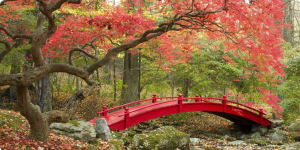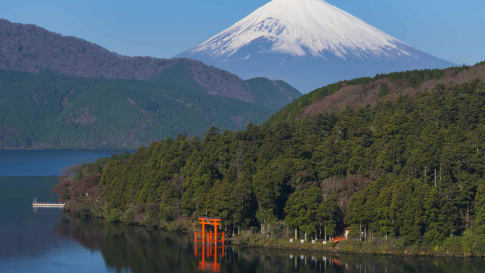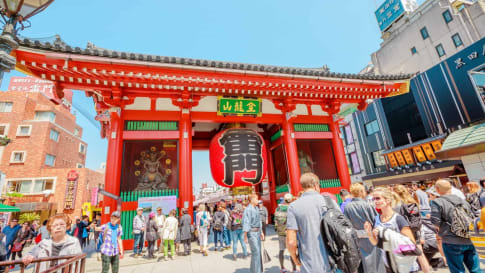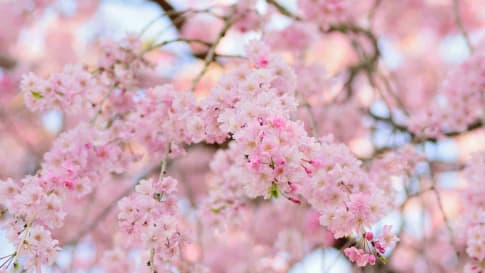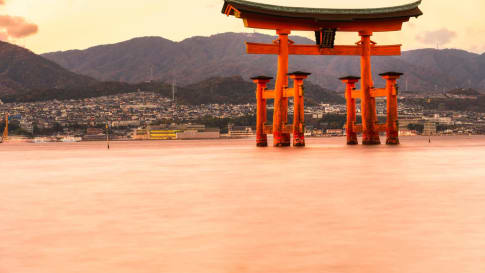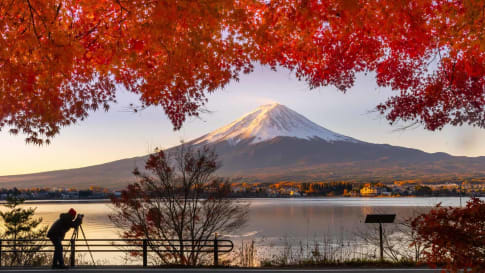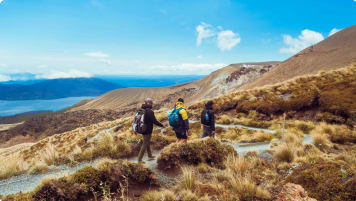Walking Japan | Small Group Tour
Escorted small group tour, Walking Japan, for mature and senior couples and solo travellers, a walking program traces the journey of 17th century Japanese poet and haiku master, Matsuo Basho. We walk in his footsteps on this 13-day journey around the northeast Tohoku region of Japan.
From $15,321NZD
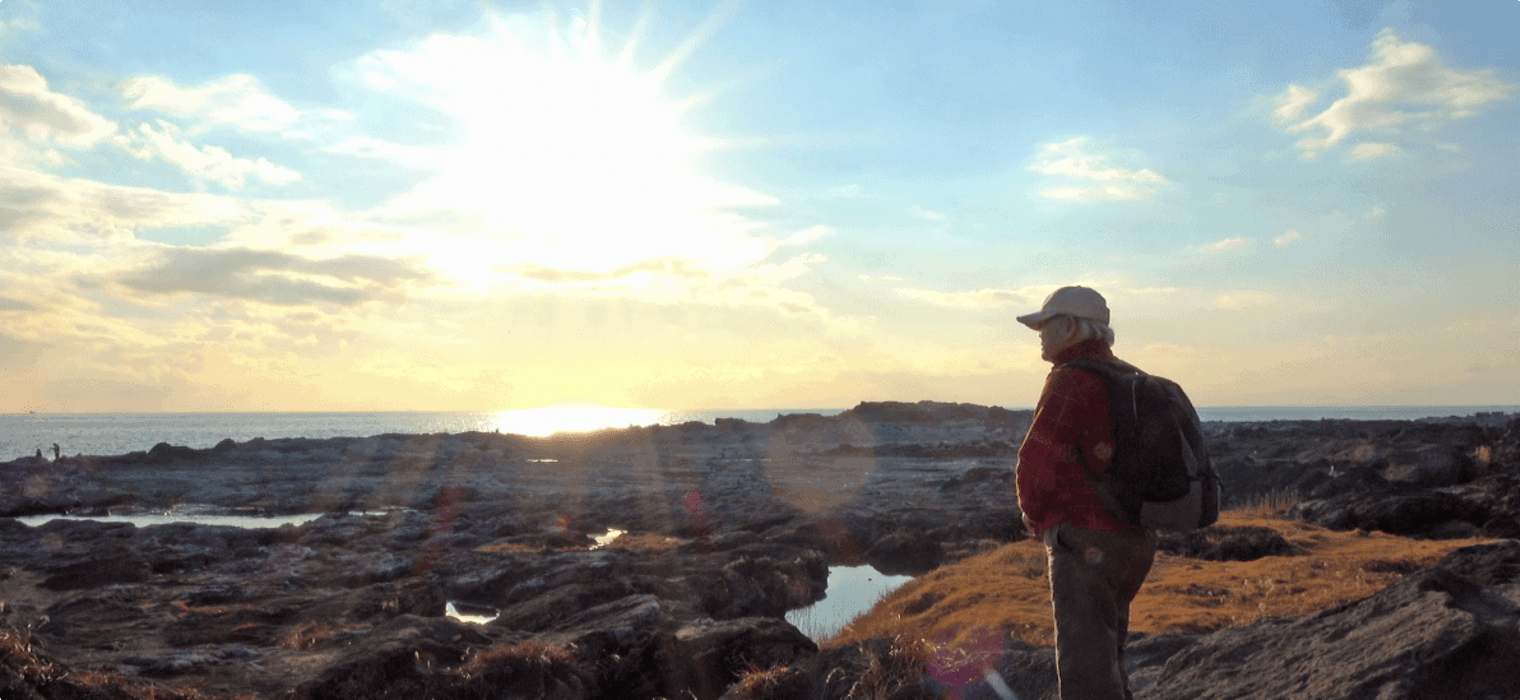
Highlights
- 1. Consider the physical and cultural landscape that influenced the 17th century poet, Matsuo Basho.
- 2. Experience the ritual of Japanese prayer on Mt. Haguro at sunrise.
- 3. Enjoy provincial Japanese lodging in charming rural and coastal areas.
- 4. Learn about how the physical environment and human history influenced the development of modern Japan.
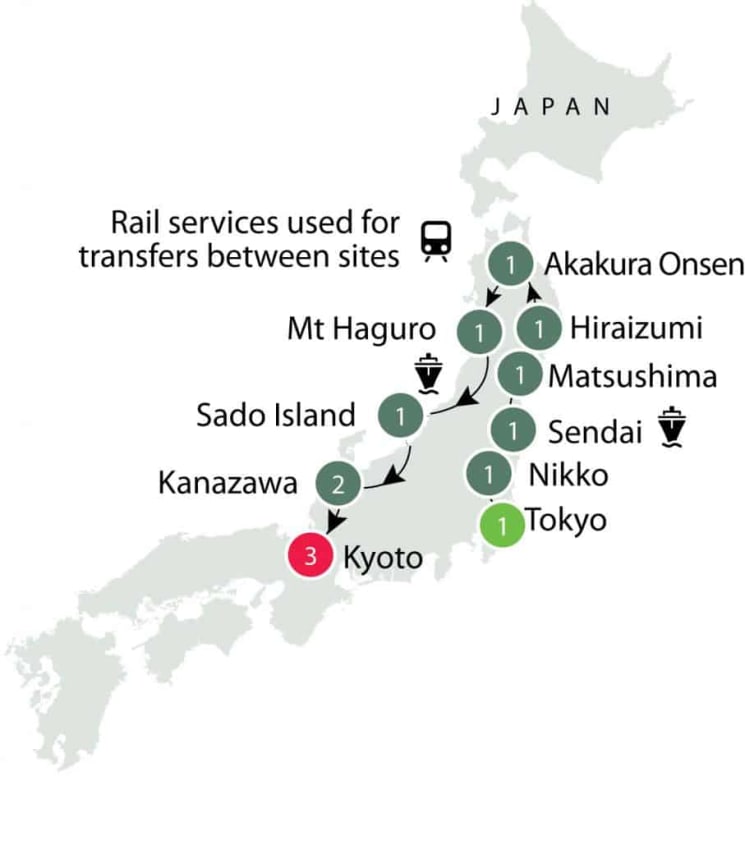
Departure Dates
| Departure Date | Price |
|---|---|
| 20 October 2025 Ends 03 November 2025 • 15 days $15,321 Twin $18,218 Single Available | Selected |
| 09 May 2026 Ends 22 May 2026 • 14 days $15,321 Twin $18,218 Single Available | |
| 19 October 2026 Ends 02 November 2026 • 15 days $15,321 Twin $18,218 Single Available | |
| 08 May 2027 Ends 21 May 2027 • days $15,863 Twin $18,786 Single Available | |
| 18 October 2027 Ends 02 November 2027 • days $15,863 Twin $18,786 Single Available |
Walking Japan | Small Group Walking Tours Japan
Odyssey offers easy, convenient, and relaxed escorted small group tours across Japan and beyond. We explore Japan's natural beauty along its coast, and Imperial heritage, its World Heritage Sites, and world famous cities, all with some truly spectacular scenery along the way. This and more is all waiting to be explored on one of Odyssey’s small group tours of Japan, designed for the senior traveller, and led by experienced, and enthusiastic like minded people.
Odyssey Traveller's Walking Japan tour traces the journey of 17th century Japanese poet and haiku master, Matsuo Basho (pseudonym of Matsuo Munefusa). Basho is credited with elevating haiku to the level of serious poetry and is often fondly remembered as the Saint of Haiku. We walk in Basho's footsteps on this Basho tour that is a 13-day journey around the northeast Tohoku region of Japan and see this area through the eyes of the great Haiku poet.
Basho, Master of the Haiku
Basho (1644-1694) was born into a samurai family in Iga Ueno Province and served the son of a local feudal lord. After his lord's death in 1666, Basho left the samurai (warrior) life and studied as a haiku poet in Kyoto under the scholar Kitamura Kigin. He later moved to Edo (modern-day Tokyo) where he became known as a poet and critic, and later to Fukagawa, site of his humble cottage, Basho-an. He named his cottage after a banana tree (basho) planted in the garden and used this as his pen name.
Haiku at the time was nothing but a literary pastime, concerned with the everyday and sometimes humorous in tone. Basho's haiku was established his own style, which reached for the eternal and elevated it to a literary art. He also travelled extensively, writing in verse and prose about his journeys creating a poetic travelogue. He met with local poets and composed linked verse (renga) with them.
His Oku no hosomichi (The Narrow Road to the Deep North) describes his visit to northern Japan and is considered one of the most elegant and beautiful works of Japanese literature.
Basho died in what is now Osaka in 1694.
Walk with the Poet
Our Walking Japan small group tour begins in Tokyo and ends in the ancient capital of Kyoto. It is suitable for mature travellers, whether travelling solo or as a couple. This educational tour is accompanied by professional guides who share their knowledge on the culture and history of Japan and the poet Matsuo Basho. A reasonable level of fitness is expected to be join this small group tour.
The Walking Japan small group tour begins with a must-see Tokyo experience, a walking tour of the Tsukiji fish market. Following this, we continue our walk through the streets of downtown old Tokyo (Edo) to Fukagawa, the location of Matsuo Basho's "banana tree hut". Here, we visit the impressive Fukagawa Edo Shiryokan, and learn about Edo’s history. We also take a walking tour of the nearby Basho Museum.
We then continue our journey through old Edo to Asakusa, now the home of the Eddoko, the original townspeople of Edo (Tokyo). The area has long been famous for its Senso-ji temple. We also take time to explore the surrounding streets that provide a sense of the local culture that is still connected to its Edo and early Tokyo roots. In the mid-afternoon, we board a train from Asakusa to Nikko, arriving in time for bathing and dinner. Our Walking Japan tour then continues with a steady rhythm each day, following the coast.
Other highlights on our Walking Japan tour include experiencing the ritual of Japanese prayer on Mt. Haguro at sunrise, and enjoying Japanese lodging in charming rural and coastal areas. We also explore numerous cities, hot springs, shrines, temples, and sunrises, from the coast to mountain passes.
We set out to walk an average of 10 kilometres per day along well-formed paths, trails, and country lanes. These are undulating paths in mountainous areas but easily managed by regular walkers.
Participants on our Walking Japan tours typically walk for up to five hours each day through the stunning landscapes of Japan, resting each evening in quality accommodation. We enjoy many of the fine foods, wines, and other delicacies that the country has to offer. A good level of fitness is recommended (Odyssey Traveller Fitness Level 3) for this small group program. You will need good walking boots, extra layers of warm clothing, and a windbreaker/waterproof layer. You'll need to carry a sunhat, water bottle, and a lunchbox in your daypack.
You can learn more about Japan with our country profile where all other departures are listed as well. Odyssey Traveller offers a range of walking tours each year paced for senior travellers. The collection of walks are for active mature and senior travellers, particularly those who seek out walking tours that are typically off the main circuit. Click through to see the complete list of small group walking tours offered.
For more details about this tour, click the ‘Top 5’ or ‘Itinerary’ buttons above! If you’re keen to experience this tour, please call or send an email. Or, to book, simply fill in the form on the right hand side of this page.
Articles preparing senior travellers to this Walking Japan small group tour
These are Odyssey's articles to help senior travellers prepare for a walking program:
- articles on Selecting walking shoes for women
- article on footwear and walking shoes
- article on what to pack when travelling
- article on maintaining muscle fitness in senior and mature age travellers
- article on selecting socks for walking
- article detailing six great short walks in Britain
- article on preparing for a walking holiday
- article on Pilgrim walks in Europe
- article on walking in there Lake District
These articles are published by Odyssey Traveller or are carefully selected external sources to maximise our senior travellers' knowledge and enjoyment of the country:
- A history of Tokyo
- Shoguns of Japan
- Around the world in six coffees
- Forest bathing in Japan
- Celebrating the Cherry Blossom; Hanami
- Travel tips for travellers to Japan
- Ten of the best books on Japan
- Japan's UNESCO World Heritage sites
- Japan by Marianna Zanetta; travel tips and advice
- Story of Modern Japan; Dr. Christopher Harding
Refreshed December 2020.
Gallery

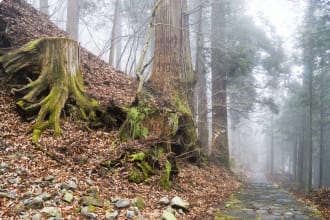
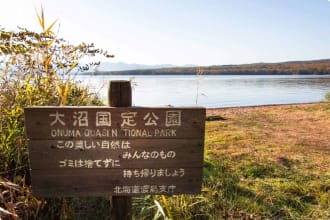
Itinerary
15 days
Day 1: Tokyo (Edo)
Accommodation: Royal Park Hotel THE Shiodome or similar
Participants arrive in Tokyo and make their way to our accommodation. In the evening we meet for a program briefing and welcome dinner.
(D)
Day 2: Tokyo – Nikko
Accommodation: Royal Park Hotel THE Shiodome or similar
After breakfast we will dispatch our main baggage by courier to Sendai, our destination on Day 4. We must, therefore, carry in our daypacks toiletries and other necessities for the coming night, as we will be without our main luggage. Our day starts with a morning visit to Tsukiji fish market, one of the ‘must-see’ Tokyo experiences. Following this, we continue our walk through the streets of downtown old Tokyo (Edo) to Fukagawa, the location of Matsuo Basho’s “banana tree hut”. Here, we visit the impressive Fukagawa Edo Shiryokan and learn about Edo’s history, as well as the nearby Basho Museum.
We then continue our journey through old Edo to Asakusa, now considered the home of the Eddoko, or the original townspeople of Edo/Tokyo. The area has long been famous for its Senso-ji temple but we also take time to explore the surrounding streets that provide a sense of the local culture that is still connected to its Edo and early Tokyo roots.
Mid-afternoon we board a train from Asakusa to Nikko, arriving in time for dinner.
(B,D)
Day 3: Nikko - Sendai
Accommodation: Hotel Richmond Sendai or similar
After breakfast the group will take taxis to the entrance of Uramigataki Waterfall and then walk back along country paths and roads to the magnificent Toshogu Shrine. During our visit to the Toshogu Shrine we will learn about how the Tokugawa family united Japan at the beginning of the Edo period.
Following our visit to Toshogu Shrine we board a charter vehicle which will take us to the Shirakawa Barrier, the formal entry point into the Tohoku Region of Japan. After an 80 km journey on our bus we will get off at close to the Sakai-no-myojin Shrine which Basho visits, and then walk a section of the ancient Unohana Highway to the Shirakawa Barrier. The highway passes through pleasant hills and rice paddies. The old Barrier itself is clearly marked among giant cedar trees and is a feature of Basho’s writing.
Our bus will pick us up at the Barrier and take us into the town of Shirakawa (famous for one of the three largest lantern festivals in Japan), before we travel on a further 160 km by Shinkansen bullet train to Sendai City, the centre of the Edo period Date Domain where we will stay overnight.
(B,D)
Day 4: Sendai - Matsushima
Accommodation: Century Hotel Matsushima or similar
After breakfast we will dispatch our main baggage by courier to Hiraizumi, our destination on Day 6. We must, therefore, carry in our daypacks toiletries and other necessities for the coming night, as we will be without our main luggage.
A small local train will take us from Sendai Station to Tagajo Station in 21 minutes. An introduction to Tohoku History will allow us to explore the museum and the remains of Taga Castle at our leisure before beginning the interesting walk along the road Basho took to Shiogama Port.
At the port we will board the last Basho cruise of the day at 3:30pm. The ferry crossing takes 50 minutes and follows the route Basho took on his boat ride from Shiogama, the salt-making capital of Japan, to Matsushima, renowned for being one of the three most beautiful places in Japan. Basho longed to visit here and it is an interesting place from which to reflect on the history of the Tohoku region of Japan.
(B,D)
Day 5: Matsushima - Hiraizumi
Accommodation: Hotel Musashibo or similar
Following breakfast, we walk to Zuiganji and be the first through the gates at 8am for a tour of the area. The striking avenue of cedars on the approach to the temple was planted only 120 years ago. To the right of the forest are the two levels of caves in which priests lived and conducted their retreats. Today they look damp and cold, but they face south, and before the cedars were planted, would have been warm and inviting places to stay. Although Zuigan-ji itself is currently undergoing restoration, we visit the remarkable gardens of nearby Entsu-in, learning more about the Date domain and family history.
We will then make our way to Matsushima Station on the Tohoku Local Line for the 11:04 am train to Hiraizumi arriving at 12:31. Lunch is by your own arrangement but we suggest buying a lunch box or similar in the area of Hiraizumi Station and eating in the beautiful grounds of the Motsuji Temple.
After lunch we will explore the magnificent gardens of Motsuji Temple, and take a walking trail to Chusonji Temple and the famous fully restored golden sutra hall. There is a recorded explanation in English inside the golden sutra hall.
On our way back to our hotel, we take time to visit Hiraizumi’s excellent new visitor centre, built to coincide with its recognition as Japan’s newest UNESCO World Heritage Site. (B,D)
Day 6: Hiraizumi - Akakura Onsen
Accommodation: Ryokan Yunohara or similar
We take the train from Hiraizumi to Naruko Onsen, picking up lunch en-route and walk from Shitomae Barrier over the mountains on the old Dewa Kaido Highway to the original Barrier Keeper’s home where Basho is known to have stayed and where we will listen to a lecture from a volunteer guide. We will enjoy lunch at a pleasant spot by a river along the trail.
We will stay at the Akakura Hot Springs resort and transfer by bus from the Barrier Keeper’s Home to the Yurakkusu Warabenouta Yunohara Inn.
(B,D)
Day 7: Akakura Onsen - Mt. Haguro
Accommodation: Hagurosan Saikan or similar
After our Basho breakfast we will dispatch our main baggage by courier to Sado, our destination on Day 9. We must, therefore, carry in our daypacks toiletries and other necessities for the coming night, as we will be without our main luggage. Following our Basho breakfast we will walk over the Natagiri Mountain pass. Along with yesterday’s mountain walking we can get a true feel for how Basho must have felt crossing the central mountains of northeastern Japan. The walk starts off with a steady climb, followed by a descent along well formed paths and easy steps.
We will use a charter bus service to then taxi us to Mogamigawa Line Kudari (48km, 1 hour 30 min). where we will board a small boat for a trip (similar to the one Basho braved) down the rapids of the mighty Mogami River.
(B,D)
Day 8: Mt Haguro - Sado Island
Accommodation: Hotel Ohsado or similar
After an early rise with the priests to partake in prayers at the shrine between 7:00am and 7:20am and a simple vegetarian breakfast, depart by road and rail for for Niigata and our transport across to Sado.
We will stay overnight in Aikawa at the relaxing hot springs resort hotel Ohsado Hotel. A bus will collect us from the port on our arrival and drop us at the famous Sado Gold mine. A large vein of gold was discovered in Aikawa in the Edo period and most of Japan’s Edo Period currency was minted from Sado gold. The large, well protected processions which carried the gold from Izumozaki, where Basho stayed on the mainland coast, used the main highway systems of the Edo period.
We walk back through the streets of old Aikawa to our hotel, where dinner will be the island’s specialty – fresh fish from the Sea of Japan. After dinner you may relax in the outdoor hot spa overlooking the Sea of Japan and think about the meaning of Basho’s most famous poem, which reflects on the role of humankind in the vastness of the universe.
(B,D)
Day 9: Sado Island - Kanazawa
Accommodation: Kanazawa New Grand Hotel or similar
In the morning our charter tour bus will pick us up and our tour of the island will commence. Weather permitting, we will enjoy a hike to the peak of Mt. Donden, and travel by bus to the southern part of this island with its rugged coastline, as well as experiencing more of the cultural features of the island. There will be ample opportunity to stretch our legs and maximise our time on the island in order to see as much as possible.
We will depart from Ogi Port for Naoetsu at 4:30pm, arriving by mid-evening in Kanazawa.
(B)
Day 10: Kanazawa
Accommodation: Kanazawa New Grand Hotel or similar
After breakfast we will proceed to Isurugi Station and the start of Kurikara Toge Mountain Pass crossing. This is a lovely walk which Basho undertook along undulating mountain paths. We will pass through a well preserved post town on the ancient highway, and see some of the temples and shrines mentioned by Basho in his poetry, as well as the site of an important medieval battlefield.
In the late afternoon we will visit Kenrokuen gardens. These are known as one of the three most beautiful gardens in Japan.
(B)
Day 11: Kanazawa - Kyoto
Accommodation: Royal Park Hotel THE Kyoto or similar
We will spend the morning walking through the ancient streets of Kanazawa, visiting an old samurai precinct and areas mentioned by Basho in his poetry.
We will then enjoy lunch at Kincharyo, Kanazawa’s best ryokan. With only a few rooms and at a hefty US$700 per night price tag, we can save our pennies and come back again to stay here in the future. In the meantime, the owners of this Kaga clan retainer building would be delighted to allow us to have a full kaiseki lunch in the rooms overlooking the Sai River, one of the best locations in Kanazawa.
Journeying to Kyoto mid-afternoon, we will enjoy our last dinner together in Pontocho, one of the Geisha districts of Kyoto, in a discreet restaurant nearby Kyoto’s Kamo River. (B,L,D)
Day 12: Kyoto
Accommodation: Royal Park Hotel THE Kyoto or similar
Following breakfast, transfer to Ginkaku-ji, the Silver Pavilion temple, which was built by the 8th Ashikaga Shogun in the late 15th Century. In the beautiful surroundings of this temple we ook at Higashiyama (East Mountain) Culture and its greatest development, chado. The Silver Pavilion, an exquisite structure, which is silver in name only, is set in beautiful gardens and provides an apposite setting for our exploration of Kyoto culture. A leisurely stroll from the temple along the Philosopher’s Path, through quiet suburbs and past many temples, brings us to the Heian-jingu Shrine. Here we delve into Japan’s Shinto roots and gain an idea of how Kyoto used to look in its earliest days. A nearby museum is the setting for an entertaining introduction to the many and splendid crafts of the city.
Afterwards we transfer by taxi to Daitoku-ji temple, one of Japan’s finest Zen monasteries, a complex of main and sub-temples covering 56 acres. We take lunch within Daitoku-ji at a restaurant specialising in shojin ryori, delicious vegetarian temple cuisine, after which we soak up the serene atmosphere and learn about the temple’s greatest resident, the tea master Sen-no Rikyu. We then take a short stroll to a delightful tea house, where we meet our tea master. In his expert, insightful company we enjoy an introduction to chado, a wonderful and little understood art that is firmly at the centre of Japanese culture. Misleadingly referred to in translation as the tea ceremony, chado is quite simply the making of a bowl of tea into which the host invests all his or her energy and thought for the enjoyment of their guests. Little of ceremony; much more a heartfelt hospitality. (B,L)
Day 13: Kyoto
Accommodation: Royal Park Hotel THE Kyoto or similar
Our second day starts at nearby Nijo-jo castle. At Nijo-jo we will explore the magnificent audience halls built for the Tokugawa shoguns, the rulers of Japan in the Edo Period. Transferring to Rokuon-ji temple by taxi we are introduced to Kitayama (North Mountain) Culture in the environs of Kinkaku-ji, the Golden Pavilion. The Pavilion, coated in gold leaf and reflected in the still lake surrounding it, is probably Japan’s most recognisable icon.
We travel on to nearby Ryoan-ji temple and its world famous garden, considered to be the epitome of a Zen garden. From there it is a short walk to a small train station, where we ride a local tram-cum-train to Arashiyama in the west of Kyoto. Here we lunch on soba, buckwheat noodles, a simple but delicious and popular dish. After, we stroll through the low hills of Arashiyama. The scenery is more reminiscent of rural Japan than a city and here we visit a gorgeous, almost delicate, temple that is associated with Gio, a concubine of Taira-no-Kiyomori. Taira was a central figure in The Tale of Heike, the epic story of the power struggle between the Taira and Minamoto Clans that engulfed Japan in the 12th Century. Here we also visit Rakushisha, which is forever associated with Japan’s greatest poet, Basho.
Later, we continue on our walk through quiet, elegant suburbs before taking another train back to Shijo-Omiya in west-central Kyoto before transferring to the hotel where the tour ends.
(B,L)
Day 14: Kyoto
Our tour ends today after breakfast.
Tour Notes
- Please bring an overnight bag as on 3 occasions we will be sending our main luggage ahead of us by courier service.
- Limit luggage to one medium suitcase with wheels and one carry on that you can manage independently.
- As there is no porter service in Japan, you must be able to transport your own baggage for short distances and on/off trains.
- Group size is limited to a maximum of 15 participants.
Includes / Excludes
What’s included in our Tour
- 13 nights accommodation in hotels and guest houses
- 12 breakfasts, 3 lunches, and 9 dinners.
- Transport, field trips and excursions as indicated in the itinerary.
- All sightseeing including entrance fees.
- Local guides for the duration of the tour.
- Odyssey Program leader.
- Detailed tour information booklet.
What’s not included in our Tour
- Return economy class international airfare and departure taxes.
- Airport transfers.
- Comprehensive travel insurance.
- Items of personal nature (laundry, phone calls, meals not included in the itinerary)
Participants must be in excellent health, extremely mobile and live an active lifestyle. Program activities may include up to 6 hours of continuous strenuous, moderate-to-fast paced activities per day on varied terrain.
Book now
Make it a private tour
Easing your journey
Crossing international borders with restrictions
The list of requirements to travel internationally has changed and will continue to change for several years. Odyssey is here to assist you in managing your way through these requirements:
For more information see our Crossing international borders with restrictions page.
Book With Confidence
If less than 30 days before your tour starts you are unable to travel as a result of Government travel restrictions, Odyssey Traveller will assist you with a date change, provide you with a credit or process a refund for your booking less any non-recoverable costs.
See Terms and conditions for details.
Peace of Mind Travel
The safety of our travellers, tour leader, local guide and support staff has always been our top priority and with the new guidelines for public health and safety for keeping safe for destinations around the world, we’ve developed our plan to give you peace of mind when travelling with us.
See Peace of Mind Travel for details.
Reading List Download PDF
A Geek in Japan: Discovering the Land of Manga, Anime, Zen, and the Tea Ceremony
Hector Garcia
For every fan of manga, anime, J-pop, or Zen, A Geek in Japan is a hip, smart and concise guide to the land that is their source.
Comprehensive and well informed, it covers a wide array of topics in short articles accompanied by sidebars and numerous photographs, providing a lively digest of the society and culture of Japan. Designed to appeal to the generations of Westerners who grew up on Pokemon, manga and video games, A Geek in Japan reinvents the culture guide for readers in the Internet age.
Spotlighting the originality and creativity of the Japanese, debunking myths about them, and answering nagging questions like why they're so fond of robots, author Hector Garcia has created the perfect book for the growing ranks of Japanophiles in this inspired, insightful and highly informative guide.
Modern Japan: A Very Short Introduction (Very Short Introductions)
Christopher Goto-Jones
Japan is arguably today's most successful industrial economy, combining almost unprecedented affluence with social stability and apparent harmony. Japanese goods and cultural products are consumed all over the world, ranging from animated movies and computer games all the way through to cars, semiconductors, and management techniques. In many ways, Japan is an icon of the modern world, and yet it remains something of an enigma to many, who see it as a confusing
montage of the alien and the familiar, the ancient and modern. The aim of this Very Short Introduction is to explode the myths and explore the reality of modern Japan - by taking a concise look at its history, economy, politics, and culture.
Bending Adversity: Japan and the Art of Survival
David Pilling
A pacy, fresh and surprising portrait of Japan and the Japanese - from David Pilling, award-winning writer and Asia Editor of the Financial Times
Despite years of stagnation, Japan remains one of the world's largest economies and a country which exerts a remarkable cultural fascination. David Pilling's new book is an entertaining, deeply knowledgeable and surprising analysis of a group of islands which have shown great resilience, both in the face of financial distress and when confronted with the overwhelming disaster of the 2011 earthquake.
The resulting tsunami, which killed some 19,000 people, and nuclear catastrophe highlighted both the deeply impressive practical resilience of ordinary Japanese and a political culture of extraordinary carelessness and arrogance. Pilling describes the emergency and its aftermath, but then writes far more broadly about many aspects of Japan which are little known to outsiders and which do so much to explain these contradictory responses to the earthquake. Bending Adversity is a superb work of reportage and the essential book even for those who already feel they know the country well.
For Fukui's Sake: Two years in rural Japan
Sam Baldwin
Far from the high-tech, high-rise of the super-cities, there lies another Japan.
A Japan where snakes slither down school corridors, where bears prowl dark forests and where Westerners are still regarded as curious creatures. Welcome to the world of the inaka – the Japanese countryside.
Unhappily employed in the UK, Sam Baldwin decides to make a big change. Saying sayonara to laboratory life, he takes a job as an English teacher in a small, rural Japanese town that no one – the Japanese included – has ever heard of.
Arriving in Fukui, where there’s ‘little reason to linger’ according to the guidebook, at first he wonders why he left England. But as he slowly settles in to his unfamiliar new home, Sam befriends a colourful cast of locals and begins to discover the secrets of this little known region.
Helped by headmasters, housewives and Himalayan mountain climbers, he immerses himself in a Japan still clutching its pastoral past and uncovers a landscape of lonely lakes, rice fields and lush mountain forests. Joining a master drummer’s taiko class, skiing over paddies and learning how to sharpen samurai swords, along the way Sam encounters farmers, fishermen and foreigners behaving badly.
Exploring Japan’s culture and cuisine, as well as its wild places and wildlife, For Fukui’s Sake is an adventurous, humorous and sometimes poignant insight into the frustrations and fascinations that face an outsider living in small town, backcountry Japan.
A Concise History of Japan (Cambridge Concise Histories)
Brett L. Walker
To this day, Japan's modern ascendancy challenges many assumptions about world history, particularly theories regarding the rise of the west and why the modern world looks the way it does. In this engaging new history, Brett L. Walker tackles key themes regarding Japan's relationships with its minorities, state and economic development, and the uses of science and medicine. The book begins by tracing the country's early history through archaeological remains, before proceeding to explore life in the imperial court, the rise of the samurai, civil conflict, encounters with Europe, and the advent of modernity and empire. Integrating the pageantry of a unique nation's history with today's environmental concerns, Walker's vibrant and accessible new narrative then follows Japan's ascension from the ashes of World War II into the thriving nation of today. It is a history for our times, posing important questions regarding how we should situate a nation's history in an age of environmental and climatological uncertainties.
An Introduction to Japanese Society
Yoshio Sugimoto
Now in its fourth edition, An Introduction to Japanese Society remains essential reading for students of Japanese society. Internationally renowned scholar Yoshio Sugimoto uses both English and Japanese sources to update and expand upon his original narrative in this sophisticated yet highly readable text. This book explores the breadth and diversity of Japanese society, with chapters covering class, geographical and generational variation, work, education, gender, minorities, popular culture and the establishment. Updates include an exploration of the 'Cool Japan' phenomenon and the explosion of Japanese culture overseas. This edition also features the latest research into Japanese society, updated statistical data, and coverage of recent events including the 2011 earthquake and tsunami, and the change in government. Written in a clear and engaging style, An Introduction to Japanese Society provides an insight into all aspects of a diverse and ever-evolving contemporary Japan.
Lost Japan
Alex Kerr
An enchanting and fascinating insight into Japanese landscape, culture, history and future.
Originally written in Japanese, this passionate, vividly personal book draws on the author's experiences in Japan over thirty years. Alex Kerr brings to life the ritualized world of Kabuki, retraces his initiation into Tokyo's boardrooms during the heady Bubble Years, and tells the story of the hidden valley that became his home.
But the book is not just a love letter. Haunted throughout by nostalgia for the Japan of old, Kerr's book is part paean to that great country and culture, part epitaph in the face of contemporary Japan's environmental and cultural destruction.
Winner of Japan's 1994 Shincho Gakugei Literature Prize.
Alex Kerr is an American writer, antiques collector and Japanologist. Lost Japan is his most famous work. He was the first foreigner to be awarded the Shincho Gakugei Literature Prize for the best work of non-fiction published in Japan.
